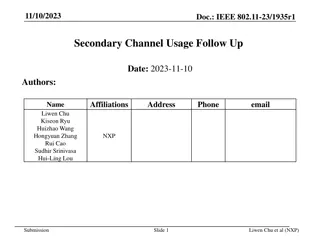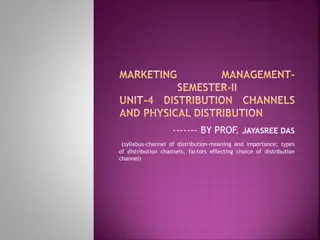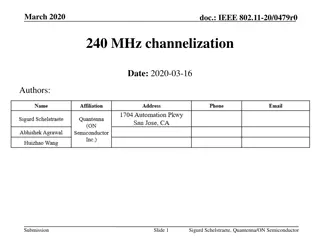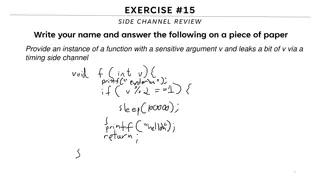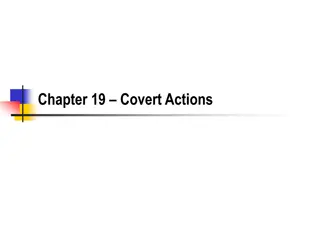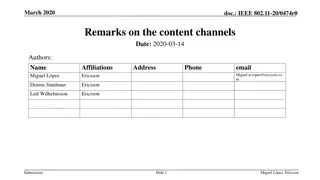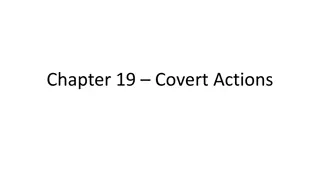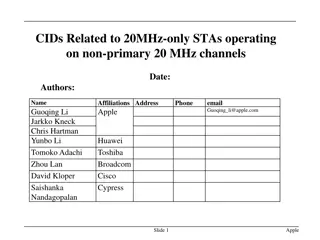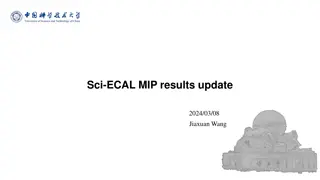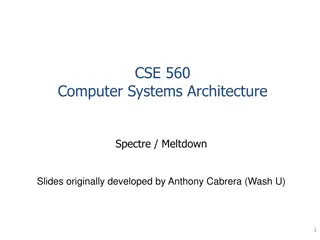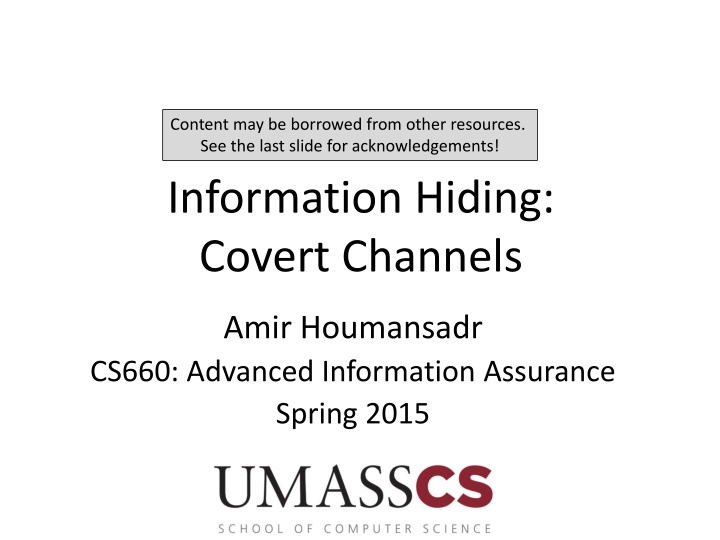
Covert Channels and Information Hiding in Cybersecurity
Explore the concepts of covert channels, digital watermarking, steganography, and more in cybersecurity. Learn about the importance, classifications, and applications of information hiding techniques. Discover how covert channels can bypass security policies and evade surveillance, posing a challenge for detection while potentially compromising secure systems.
Download Presentation

Please find below an Image/Link to download the presentation.
The content on the website is provided AS IS for your information and personal use only. It may not be sold, licensed, or shared on other websites without obtaining consent from the author. If you encounter any issues during the download, it is possible that the publisher has removed the file from their server.
You are allowed to download the files provided on this website for personal or commercial use, subject to the condition that they are used lawfully. All files are the property of their respective owners.
The content on the website is provided AS IS for your information and personal use only. It may not be sold, licensed, or shared on other websites without obtaining consent from the author.
E N D
Presentation Transcript
Content may be borrowed from other resources. See the last slide for acknowledgements! Information Hiding: Covert Channels Amir Houmansadr CS660: Advanced Information Assurance Spring 2015
Classes of Information Hiding Digital watermarking Steganography Covert channels Anonymous communication Protocol obfuscation CS660 - Advanced Information Assurance - UMassAmherst 2
Covert Channels Definition: Communicate information between two computer processes that are not allowed to communicate, by hiding information into shared resources Steganography: hiding information into digital media CS660 - Advanced Information Assurance - UMassAmherst 3
Prisoners problem Alice, Bob, and Walter CS660 - Advanced Information Assurance - UMassAmherst 4
Applications, or Why Use Covert Channels Bypass security policy by malicious/compromised computer processes Evade surveillance Bypass communication restrictions Etc. CS660 - Advanced Information Assurance - UMassAmherst 5
What Is the Importance? Difficult to detect Can operate for a long time and leak a substantial amount of classified data Can compromise an otherwise secure system, including one that has been formally verified!
Classification: Hiding Method Storage channel Data transmitted by writing or abstaining from writing, e.g., writing into RAM Timing channel Data modulated into the timing, or occurrence of events, e.g., the times between network packets CS660 - Advanced Information Assurance - UMassAmherst 7
Classification: Shared Resources Network resource: an existing, legitimate communication channel designed for some purpose Remote (network) covert channels Computer resource: RAM, HardDisk, CPU, etc. Local covert channels CS660 - Advanced Information Assurance - UMassAmherst 8
Local Channels CS660 - Advanced Information Assurance - UMassAmherst 9
Virtual Machines Shared resources: CPU RAM Disk Network Examples? CS660 - Advanced Information Assurance - UMassAmherst 10
Smartphones Shared resources: CPU RAM Disk Network Microphone/speaker Battery Examples? CS660 - Advanced Information Assurance - UMassAmherst 11
Remote (Network) Channels CS660 - Advanced Information Assurance - UMassAmherst 12
What is the shared resource here? CS660 - Advanced Information Assurance - UMassAmherst 13
Types Timing E.g., packet timings Storage E.g., packet headers How about the information hidden in packet payload? Steganography CS660 - Advanced Information Assurance - UMassAmherst 14
Protocol Stack CS660 - Advanced Information Assurance - UMassAmherst 15
Packet Header Hiding 20-64 bytes 20-64 bytes 0-65,488 bytes IP Header TCP Header DATA This is Information Assurance Class TCP Source Port TCP Destination Port TCP/IP Header can serve as a carrier for acovert channel IP Source Address IP Destination Address
IP Header 0-44 bytes Fields that may be used to embed covert data
TCP Header 0-44 bytes Timestam p
Storage Based Information is embedded by hiding data in packet header fields IP identification Offset Options TCP Checksum TCP Sequence Numbers
Timing Channels Information is hidden by triggering or delaying events at specific time intervals
Detection Mechanisms Storage-based Data analysis Timing-based Timing analysis CS660 - Advanced Information Assurance - UMassAmherst 22
Threat Model Passive Warden Threat Model Detect, then remove Active Warden Threat Model Modify traffic regardless of suspicion Constraint?
IP ID and TCP ISN Implementation Two fields which are commonly used to embed covert data are the IP ID and TCP ISN Due to their construction, these fields contain some structure Partially unpredictable
Detection of TCP/IP Covert Channels Each operating system exhibits well defined characteristics in generated TCP/IP fields can be used to identify any anomalies that may indicate the use of steganography Suite of tests applied to network traces to identify whether the results are consistent with known operating systems
CS660 - Advanced Information Assurance - UMassAmherst 26
CS660 - Advanced Information Assurance - UMassAmherst 27
IP ID Characteristics 1. Sequential Global IP ID 2. Sequential Per-host IP ID 3. IP-ID MSB Toggle 4. IP-ID Permutation
TCP ISN Characteristics 5. Rekey Timer 6. Rekey Counter 7. ISN MSB Toggle 8. ISN Permutation 9. Zero bit 15 10. Full TCP Collisions 11. Partial TCP Collisions
Explicit Steganography Detection 12. Nushu Cryptography encrypts data before including it in the ISN field results in a distribution which is different from normally generated by Linux and so will be detected by the other TCP tests
13. TCP Timestamp If a low bandwidth TCP connection is being used to leak information a randomness test can be applied to the least significant bits of the timestamps in the TCP packets If too much randomness is detected in the LSBs a steganographic covert channel is in use
14. Other Anomalies unusual flags (e.g. DF when not expected, ToS set) excessive fragmentation use of IP options non-zero padding unexpected TCP options (e.g. timestamps from operating systems which do not generate them) excessive re-ordering
Accuracy No false negatives Possible false positives The accuracy depends on the size of observation CS660 - Advanced Information Assurance - UMassAmherst 34
Detection-Resistant Schemes Lathra - Robust scheme, using the TCP ISNs generated by OpenBSD and Linux as a steganographic carrier Simply encoding data within the least significant 24 bits of the ISN could be detected by the warden
Other Network Channels CS660 - Advanced Information Assurance - UMassAmherst 36
ICMP Channels www.erg.abdn.ac.uk/users/gorry ICMP echo request/reply can tunnel arbitrary user data Payload capacity depends on path MTU (this feature often used to measure PMTU) Sohn, Noh, Moon 2003, Support Vector Machine Based ICMP Covert Channel Attack Detection
HTTP Channels Fields in the header Infranet StegoTorus
DNS Channels DNS can hold arbitrary text in its various fields High bandwidth: 110-220 bytes per request! Used for SSH, streaming audio Not yet filtered by firewalls Proof of concept available: OzyManDNS (http://www.doxpara.com)
Analysis Techniques Information flow Operates at high-level language level Often overestimates flows, flags non-existant flows Noninterference Analysis performed on abstract model, not real system Shared Resource Matrix Very popular with systems folks Sabelfeld, Myers 2003, Language-Based Information-Flow Security
Shared Resource Matrix Kemmerer 1983, Shared Resource Matrix Methodology: An Approach to Identifying Storage and Timing Channels
Fuzzy Time All covert timing channels rely on accurate clock You can either attempt to disrupt the timing of the channel (add noise or slow it down), or reduce the accuracy of the clock VAX security kernel slows down timer interrupt periods to be uniformly distributed with a mean of 20 ms. Randomly modifies the completion time of I/O requests, so they can t be used as a clock Hu 1991, Reducing Timing Channels with Fuzzy Time
Lattice Scheduling Many local covert channels require simultaneous operation of spy and Trojan Process scheduler can be modified to prevent this situation Hu 1992, Lattice Scheduling and Covert Channels
Wrapping Up Do covert channels pose a real threat? Some are difficult to exploit, requiring a skillful attacker Others are fairly easy to exploit: Acoustic keylogger HTTP tunnels Definitely a threat!
Classes of Information Hiding Digital watermarking Steganography Covert channels Anonymous communication Protocol obfuscation CS660 - Advanced Information Assurance - UMassAmherst 47
Side Channels Similar to covert channels, but information is leaked unintentionally Examples? CS660 - Advanced Information Assurance - UMassAmherst 48
Acknowledgement Some of the slides, content, or pictures are borrowed from the following resources, and some pictures are obtained through Google search without being referenced below: TCP/IP covert channels -UMBC Covert Channels, by Michael LeMay @UIUC 49






